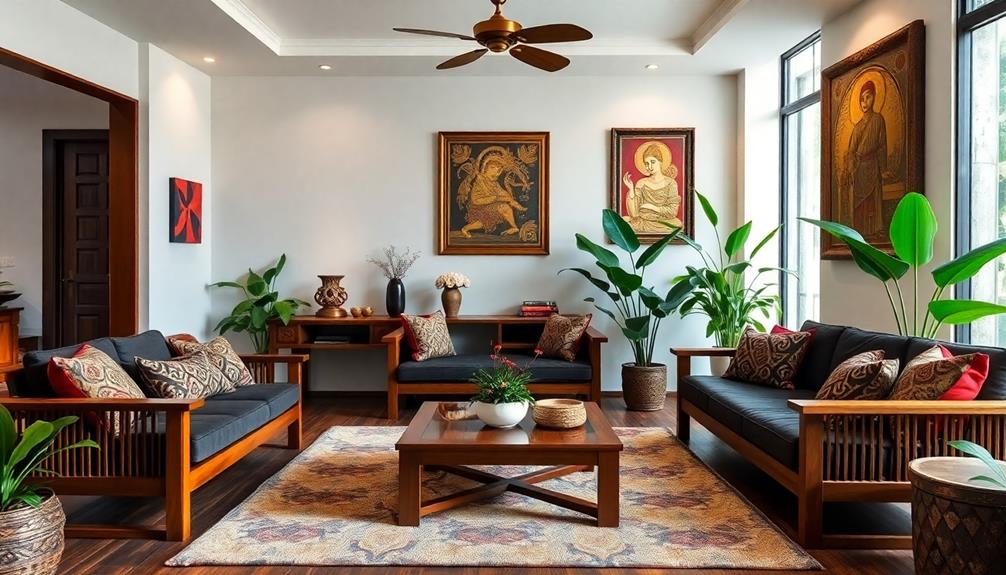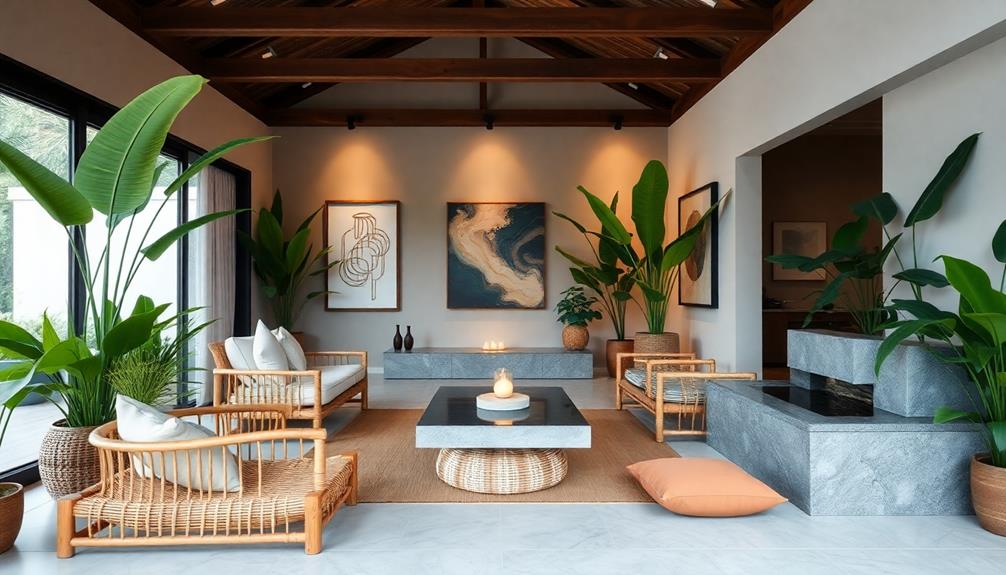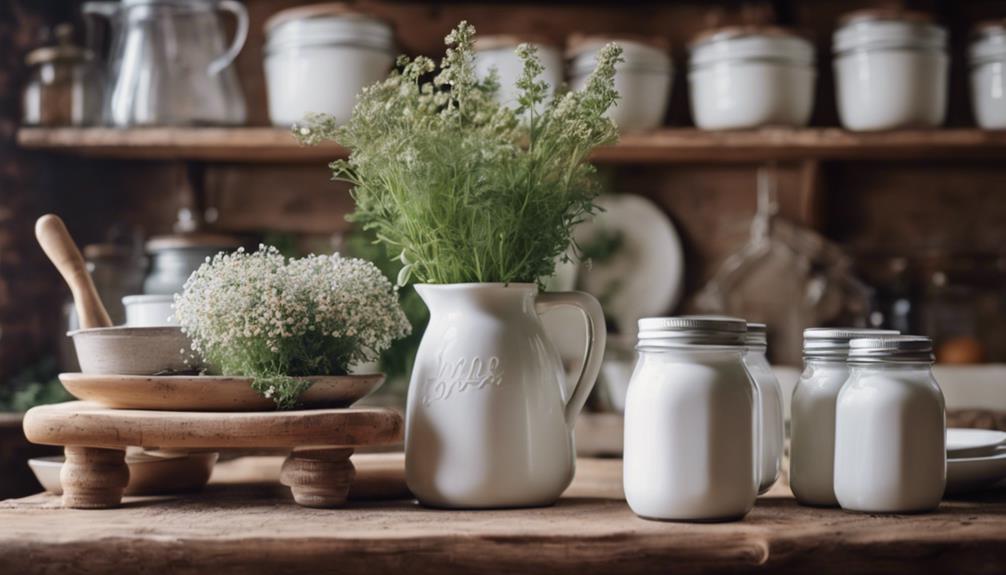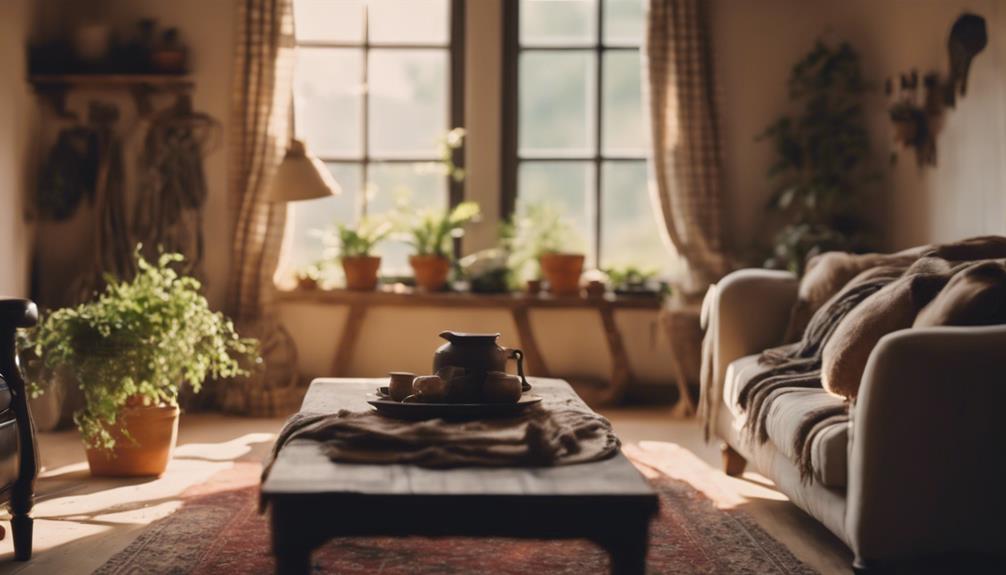Embracing Indonesian aesthetics in modern spaces lets you celebrate rich cultural heritage while creating functional and inviting environments. You can incorporate locally sourced materials, like reclaimed wood and rattan, to enhance warmth and sustainability. Blending intricate traditional patterns with minimalist designs fosters a unique visual contrast. Add handcrafted decor, like Indonesian masks, to enrich your space's character. Micro gardens not only beautify interiors but also improve air quality. This fusion of styles not only honors tradition but also supports local artisans. If you're curious about more ways to achieve this synthesis, there's so much more to explore.
Key Takeaways
- Incorporate locally sourced materials like reclaimed wood and rattan to enhance authenticity and support sustainable practices in your space.
- Balance traditional Indonesian motifs with minimalist modern design to create visually striking and culturally rich interiors.
- Utilize vibrant colors and earthy tones inspired by tropical landscapes to evoke a warm, inviting atmosphere.
- Integrate decorative elements such as Indonesian masks and traditional woven furniture for cultural depth and artistic expression.
- Implement micro gardens within interiors to promote biodiversity and improve both aesthetics and environmental health.
The Essence of Indonesian Aesthetics
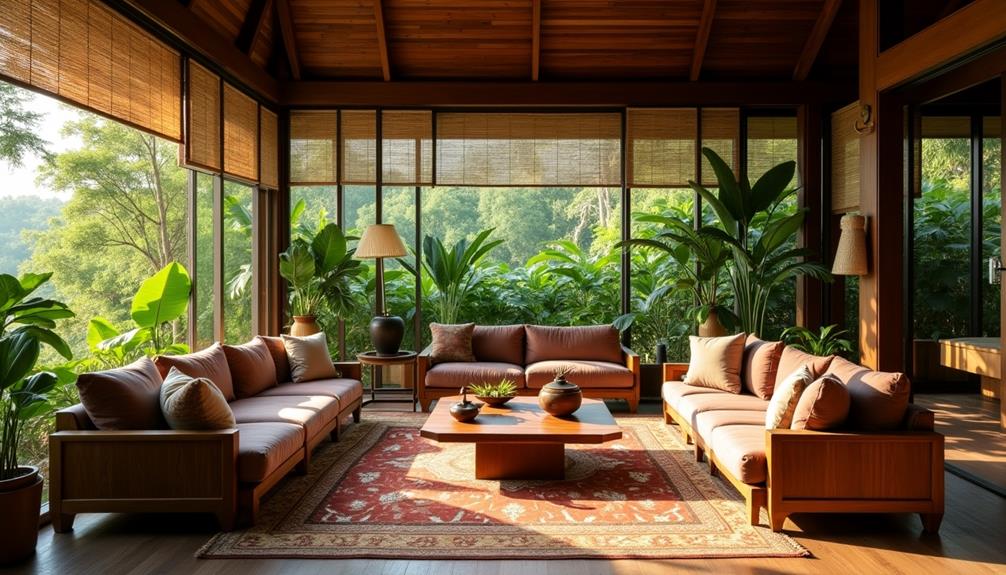
When you explore Indonesian aesthetics, you'll discover a vibrant tapestry woven from the country's rich cultural heritage. This aesthetic is deeply rooted in the diverse influences of various ethnic groups and traditions across the archipelago.
You'll notice the prominent use of natural elements, like wood and rattan, showcasing not only craftsmanship but also a profound connection to the environment. Decorative elements such as Indonesian decorative pillows add vibrant colors and intricate patterns that enhance living spaces, reflecting the cultural essence of the region.
Indonesian design embraces earthy tones and vibrant hues inspired by the lush tropical landscape, creating a harmonious palette that speaks to the heart of nature.
As you probe deeper, you'll encounter handcrafted items that tell compelling stories, each piece embodying unique cultural significance. Traditional weaving and artisanal techniques are integral, emphasizing the skill and dedication of artisans who pour their heart into every creation.
The incorporation of ornamental elements, such as intricate carvings and batik patterns, contributes to a rich visual narrative, transforming modern spaces into reflections of Indonesia's artistic expressions.
Integrating Local Materials and Crafts
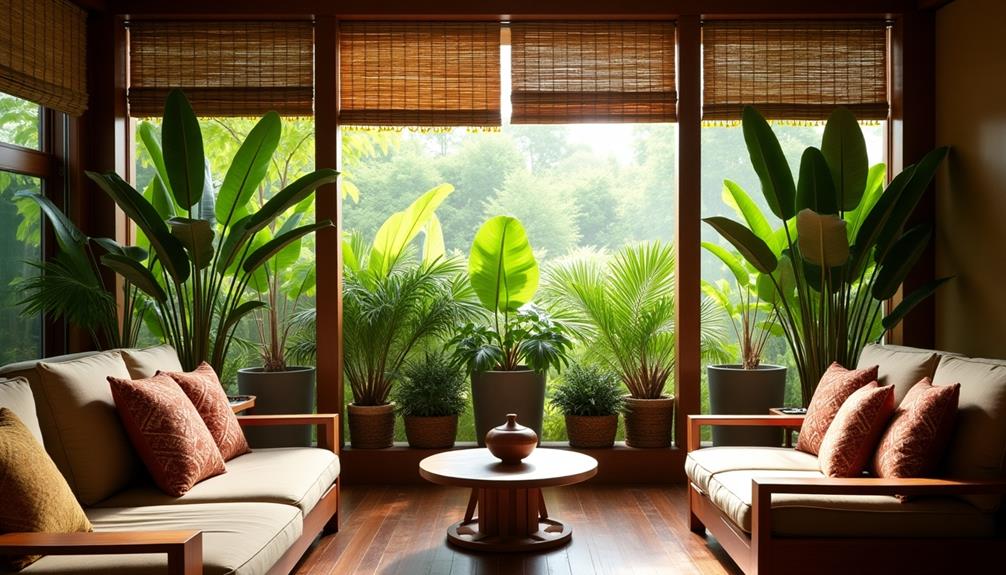
As you embrace Indonesian aesthetics, integrating local materials and crafts can transform your space into a reflection of cultural richness and sustainability.
By utilizing natural materials like reclaimed wood, stone, and locally sourced rattan, you create a connection between modern design and Indonesia's cultural heritage. Incorporating elements like the Indonesian Decor Mask adds a vibrant touch and showcases the region's artistic expressions.
Incorporating artisanal techniques, such as traditional weaving found in rattan furniture, adds unique stories and character to your interiors. Each piece carries the craftsmanship of skilled artisans, showcasing the region's rich traditions.
This approach not only enhances your space but also supports the local economy.
Focusing on sustainability, using materials like Indonesian red bricks can improve your project's acoustic quality while minimizing environmental impact.
Additionally, integrating micro gardens and natural ventilation aligns with Indonesia's commitment to sustainable living practices, bringing a refreshing change to your modern spaces.
Balancing Tradition With Modern Design
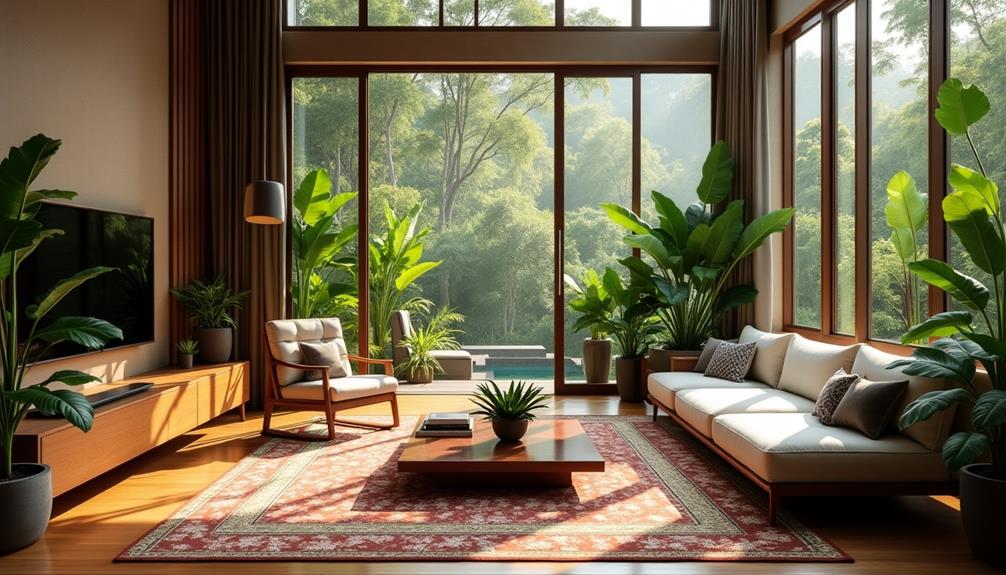
Embracing Indonesian aesthetics means finding harmony between traditional elements and modern design. In your quest to create modern spaces that reflect Indonesia's rich heritage, you can integrate intricate patterns and natural materials seamlessly. This approach not only showcases the beauty of Indonesian craftsmanship but also enhances the overall ambiance of your interiors.
| Traditional Elements | Modern Design Features |
|---|---|
| Intricate patterns | Minimalist settings |
| Locally sourced materials | Open floor plans |
| Rattan and reclaimed wood | Large windows for natural light |
| Cultural motifs | Visual contrast |
Utilizing natural materials like rattan and reclaimed wood adds an authentic touch while supporting sustainable practices. You'll find that the interplay of traditional motifs in minimalist settings creates visual contrast that honors cultural history. Additionally, by adaptive reuse of historical architecture, you preserve cultural identity while satisfying contemporary design standards.
Your design philosophy should prioritize this balance, ensuring that each element contributes to a cohesive aesthetic that respects tradition while embracing modernity. By doing so, you'll create spaces that not only look beautiful but also tell a story, bridging the past with the present.
Emphasizing Sustainability in Interiors
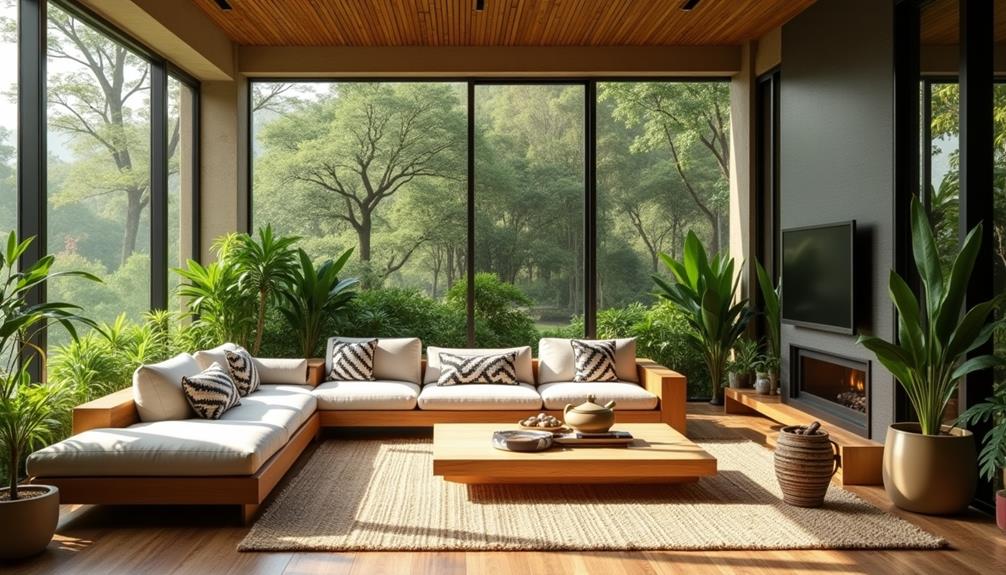
Sustainability in interiors isn't just a trend; it's a necessity that reflects a growing awareness of our environmental impact. By emphasizing sustainability, you can create spaces that not only look good but also contribute positively to the environment.
Using local materials like red bricks and rattan reduces your carbon footprint while supporting local craftsmanship. This eco-conscious approach enriches your interiors with a unique character that tells a story. Incorporating elements of Balinese design characteristics can enhance the aesthetic while promoting sustainability through eco-friendly materials.
Incorporating micro gardens into your designs enhances climate regulation and promotes biodiversity, boosting the overall well-being of the occupants. Sustainable harvesting methods in the rattan industry guarantee that these materials remain available for future use, appealing to those who prioritize eco-friendly choices.
Moreover, adopting practices like a paperless office can greatly reduce waste and improve resource efficiency. You can enhance energy efficiency by incorporating natural ventilation and maximizing daylight through large windows and skylights.
This not only reduces reliance on artificial lighting but also creates a healthier living environment. By embracing these sustainable practices in your interiors, you're not just making a style statement; you're committing to a healthier planet and a better future.
Creating Inviting and Functional Spaces
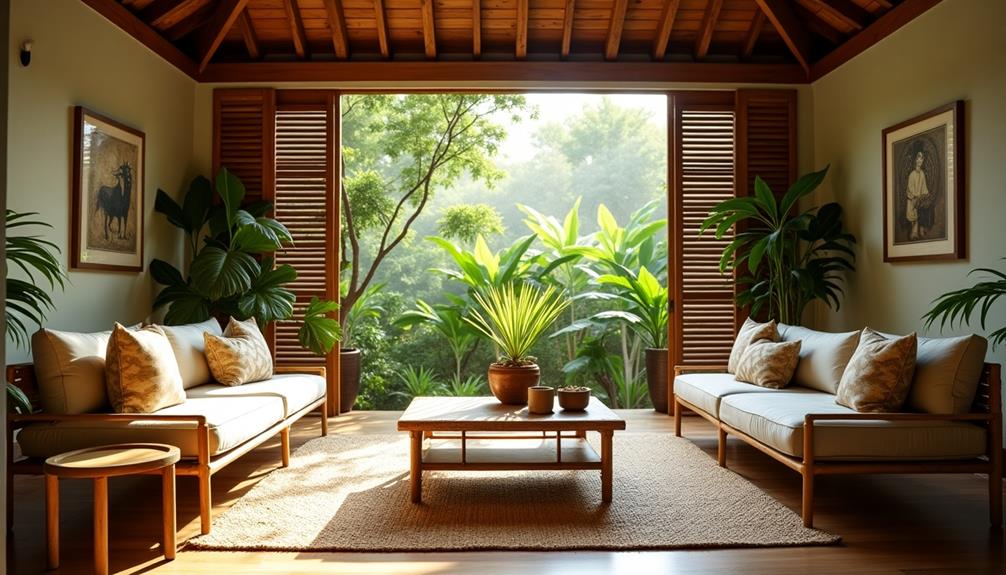
Designing spaces that invite comfort and functionality involves thoughtful choices that resonate with both aesthetics and practicality. By combining Indonesian design principles with modern elements, you can create an environment that feels warm and welcoming.
Incorporating traditional artistry through decorative pieces like Indonesian masks can further enhance the cultural depth of your interiors.
- Natural Materials: Use locally sourced wood and rattan to enhance the inviting nature of your spaces, reflecting traditional craftsmanship while promoting sustainability.
- Clean Lines: Emphasize functional furniture with sleek, clean lines made from sophisticated materials like glass and metal. This approach aligns with contemporary aesthetics while honoring cultural heritage.
- Communal Areas: Design open floor plans that encourage social interaction, allowing for communal spaces where friends and family can gather. This reflects the Indonesian value of community and enhances the overall functionality of your environment.
- Micro Gardens: Integrate micro gardens within your interiors. They not only boost aesthetic appeal but also help regulate the climate, creating a calming atmosphere that connects you to nature.
Frequently Asked Questions
What Are Key Indonesian Colors to Use in Modern Design?
In modern design, you can incorporate vibrant colors like deep reds, rich golds, and earthy greens. These hues reflect Indonesia's natural beauty and cultural heritage, adding warmth and character to your space while creating a unique atmosphere.
How Can I Source Authentic Indonesian Art for My Space?
You're on a quest for authentic Indonesian art, but where do you start? Explore local galleries, connect with Indonesian artists online, or visit cultural fairs. Each piece tells a story, waiting for you to discover.
Are There Specific Indonesian Motifs That Should Be Included?
You should consider incorporating batik patterns, wayang kulit silhouettes, and traditional geometric designs. These motifs not only reflect Indonesia's rich cultural heritage but also add depth and character to your space, enhancing its overall aesthetic.
What Are the Benefits of Using Indonesian Textiles in Interiors?
Using Indonesian textiles in interiors is like adding a warm embrace to your space. They infuse vibrant colors and intricate patterns, creating a unique atmosphere that reflects culture, fosters comfort, and sparks conversation among guests.
How Can I Incorporate Indonesian Culture Without Overwhelming the Design?
To incorporate Indonesian culture without overwhelming your design, start with subtle accents like textiles or art. Use a few key pieces to create focal points, ensuring harmony with existing elements and maintaining a balanced aesthetic.
Conclusion
Incorporating Indonesian aesthetics into modern spaces lets you weave a rich cultural tapestry that enhances your environment. By blending local materials, traditional crafts, and sustainable practices, you're not just decorating; you're creating a story that resonates with both history and contemporary life. As you embrace this fusion, remember that good design is more than skin deep—it's about creating a warm, inviting atmosphere that feels like home. So go ahead, let your space reflect the beauty of Indonesia!
